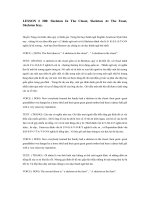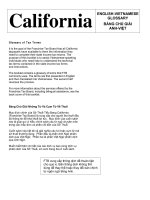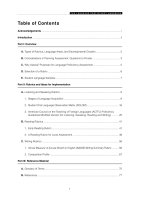Tài liệu English language learners pptx
Bạn đang xem bản rút gọn của tài liệu. Xem và tải ngay bản đầy đủ của tài liệu tại đây (41.01 KB, 10 trang )
STANDARD 2: English language learners will speak in English for a variety of basic interpersonal and academic purposes,
with fluency, using appropriate vocabulary, grammar, pronunciation, and nonverbal communication strategies.
Topic A: Speaking
DRAFT 1
Indicator 1: Ask questions for a variety of purposes
GRADE
BAND
LOW BEG HIGH BEG LOW INT HIGH INT ADVANCED
6-12
a. Ask simple questions
to request basic
information,
assistance, or
permission, such as
“What’s your
name?”/ “What’s
that?”/“Can I …?”
b. Ask a few, simple
yes/no or choice
questions using basic
sentence patterns,
such as, “Is it red or
blue?”
a. Ask questions to
request information,
assistance, or
permission using
simple, polite
question forms, such
as, “Can you help me
please?”
b. Ask a few, simple
yes/no, choice or
wh- questions using
basic sentence
patterns, such as,
“What color is it?”
a. Ask questions to
request information,
assistance, directions,
or permission using a
variety of question
forms, such as
“Would you show
me, please?”
b. Ask wh- questions
with who/which,
what, where, when,
with simple and
compound sentence
structures and correct
subject-verb
agreement, such as,
“Which resource is
good for this paper?”
c. Ask tag and
imbedded questions,
such as, “You did
your homework,
didn’t you?”
a. Ask questions to
request or clarify
information,
assistance, directions,
or permission using a
variety of question
forms, such as
“Could you tell me
where to find…?”
b. Ask wh- questions
including why and
how, with compound
and complex
sentence structures
and correct subject-
verb agreement, such
as, “How should I
answer this
question?”
c. Ask tag and
imbedded questions,
such as, “You did
your homework,
didn’t you?”
a. Ask pertinent
questions to request
or clarify
information,
assistance, directions,
or permission using a
variety of questions
forms, such as
“Could you show me
how to…?”
b. Ask a variety of
informational
questions using
affirmative and
negative sentence
structures and correct
subject-verb
agreement, such as,
“Why isn’t this the
correct answer?”
c. Ask tag and
imbedded questions,
such as, “Tell me
how to paraphrase
this quote.”
STANDARD 2: English language learners will speak in English for a variety of basic interpersonal and academic purposes,
with fluency, using appropriate vocabulary, grammar, pronunciation, and nonverbal communication strategies.
Topic A: Speaking
DRAFT 2
Indicator 2: Apply vocabulary appropriately in a variety of contexts.
GRADE
BAND
LOW BEG HIGH BEG LOW INT HIGH INT ADVANCED
6-12
a. With a great deal of
prompting, use
routine, high
frequency
expressions, such as,
“I’m going to my
locker.”
b. Use high frequency
words or phrases
appropriate to
audience and context,
when communicating
in most basic,
interpersonal
situations.
c. Use basic phrasal
verbs, such as, “Turn
on the light,” or “take
out your book.”
a. With some
prompting, use
routine expressions,
such as, “I need to go
to my locker.”
b. Use words, phrases,
and short sentences
appropriate to
audience and context,
when communicating
in interpersonal
situations.
c. Use common phrasal
verbs, such as, “I was
scared when the
plane took off.”
a. With prompting, use
routine expressions,
such as, “I forgot my
book and need to go
to my locker.”
b. Use words, phrases,
and sentences
appropriate to
audience and
context, to convey
specific ideas and
feelings.
c. Use a few idiomatic
expressions and
common phrasal
verbs differentiating
the figurative
meaning from the
literal meaning.
a. With little prompting,
use routine
expressions
independently, such
as, “I forgot my book
and need to go to my
locker.”
b. Use words, phrases,
and multiple
sentences appropriate
to audience and
context, to convey
specific ideas,
attitudes, and
feelings.
c. Use some idiomatic
expressions, slang
and phrasal verbs
distinguishing their
connotative meaning
from their denotative
meaning.
a. Use routine
expressions
independently, such
as, “I forgot my book
and need to go to my
locker.”
b. Use low frequency
words and phrases,
and multiple
sentences appropriate
to audience and
context, to convey
specific ideas,
attitudes, and
feelings.
c. Use idiomatic
expressions, slang
and phrasal verbs
distinguishing their
connotative meaning
from their denotative
meaning , such as,
“Break a leg!”
STANDARD 2: English language learners will speak in English for a variety of basic interpersonal and academic purposes,
with fluency, using appropriate vocabulary, grammar, pronunciation, and nonverbal communication strategies.
Topic A: Speaking
DRAFT 3
Indicator 3: Speak with sufficient clarity and fluency to be understood.
GRADE
BAND
LOW BEG HIGH BEG LOW INT HIGH INT ADVANCED
6-12
a. Use comprehensible
pronunciation (with
many errors) of
minimal pairs and
single syllable words
and common phrases
in basic, social
situations with many
errors, such as
have/half.
a. Use comprehensible
pronunciation (with
many errors) when
speaking in basic
social and academic
situations using
multi-syllabic words,
common phrases, and
basic vocabulary
such as, “I want to
buy a half gallon of
ice cream.”
b. Speak with some
degree of fluency
on social topics,
using simple
sentences.
a. Use appropriate
pronunciation
including word
stress, intonation,
rhythm, pitch and
inflection (with
errors) when
speaking in basic
social and academic
situations using
multi-syllabic words,
phrases, and simple
and compound
sentences such as,
“I love pizza, so I’ll
have two slices.”
b. Speak with moderate
fluency on social and
some academic
topics, using simple
sentences.
a. Use appropriate
pronunciation
including word
stress, intonation,
rhythm, pitch and
inflection (with some
errors) when
speaking in a variety
of situations, such as,
“I’ll have a half of
this sandwich.”
b. Speak with a
moderate yet non-
native degree of
fluency on a variety
of social and
academic topics,
using varied sentence
types.
a. Use appropriate
pronunciation (with
few errors) including
word stress, volume,
intonation, rhythm,
pitch and inflection
when speaking in a
variety of social and
academic situations.
b. Speak with
appropriate fluency
on a variety of social
and academic topics,
using varied sentence
types.
STANDARD 2: English language learners will speak in English for a variety of basic interpersonal and academic purposes,
with fluency, using appropriate vocabulary, grammar, pronunciation, and nonverbal communication strategies.
Topic A: Speaking
DRAFT 4
Indicator 4: Express personal information, ideas and opinions
GRADE
BAND
LOW BEG HIGH BEG LOW INT HIGH INT ADVANCED
6-12
a. Communicate basic
wants, needs and
likes/dislikes as
related to school and
social situations
using simple
repetitive phrases,
such as, “I like
apples” or “I have
algebra homework.”
c. Participate in simple
social conversations
with peers and adults.
a. Communicate basic
wants, needs and
likes/dislikes as
related to school and
social situations
using simple
sentence patterns,
such as, “I need a
calculator.”
b. Explain actions,
choices, and
decisions using
simple sentences in
social and academic
settings, such as, “I
am writing about my
grandfather. He is a
good man.”
c. Participate in
conversations with
peers and adults on
familiar topics to
accomplish social
and academic tasks.
a. Articulate wants,
needs, opinions and
feelings as related to
school and social
situations using
sentence patterns,
such as, “I think
English is harder
than Math.”
b. Explain actions,
choices, and
decisions using
simple, compound
and complex
sentences in social
and academic
settings, such as, “I
am writing about my
grandfather because
is a hero.”
c. Participate in and
paraphrase
conversations with
peers and adults, on
unfamiliar topics to
accomplish social
and academic tasks.
a. Articulate wants,
needs, opinions, and
feelings as related to
school and social
situations using
varied sentence
types, such as, “I
think that …”
b. Explain actions,
choices, and
decisions with
supporting details in
varied sentence types
in social and
academic settings,
such as, “When I am
16 I want to drive a
car to school.”
c. Negotiate and initiate
conversations by
questioning,
restating, requesting
information, and
paraphrasing the
communication of
others to accomplish
social and academic
tasks.
a. Express opinions and
feelings about specific
issues with supporting
details using varied
sentence types and
expressions, such as,
“It seems to me that
if…”
b. Explain actions,
choices, and decisions,
including hypothetical
situations in varied
sentence types in
social and academic
settings, such as, “If I
were 16, I would drive
a car to school .”
c. Negotiate interaction
by sharing and
requesting information,
expressing needs,
feelings, and ideas,
seeking assistance, and
responding
appropriately to
feedback to
accomplish social and
academic tasks.
STANDARD 2: English language learners will speak in English for a variety of basic interpersonal and academic purposes,
with fluency, using appropriate vocabulary, grammar, pronunciation, and nonverbal communication strategies.
Topic A: Speaking
DRAFT 5
Indicator 5: Use standard academic American English grammar to develop accuracy and clarity in oral communication
GRADE
BAND
LOW BEG HIGH BEG LOW INT HIGH INT ADVANCED
6-12
a. Communicate using
high frequency
words, phrases, and
memorized sentence
patterns with
affirmative and
negative statements
and simple
interrogatives.
b. Communicate with
many errors, using
some common verbs
in declarative and
interrogative
statements with
simple present and
present progressive
tenses.
c. Use basic, high
frequency modifiers
to augment oral
language, such as
adjectives and
adverbs in simple
descriptions.
d. Use correct subject
pronouns to convey
meaning, such as,
“She is my friend.”
a. Communicate using
words, phrases,
interrogatives,
affirmative and
negative statements
and short imperative
statements with
correct subject-
verb agreement.
b. Communicate with
errors, using
common verbs in
simple present,
regular past, future,
and present and past
progressive tenses.
c. Use modifiers to
augment oral
language, such as
adjectives and
adverbs in simple
descriptions.
d. Use correct subject
and possessive
pronouns to convey
meaning, such as
“Where’s my
friend?”
a. Communicate using
simple, compound
and some complex
affirmative and
negative statements
and short imperative
statements with
correct subject-verb
agreement.
b. Communicate with
errors, using verbs in
simple present,
regular and some
irregular past, future
tenses, present and
past progressive
tenses, some
perfect tenses, and
some conditionals.
c. Use modifiers in
correct word order to
augment oral
language, such as in
“beautiful, blue
coat.”
d. Use correct
possessive and
reflexive pronouns to
convey meaning,
such as, “It’s your
book, not mine,” and
“I gave it to her
myself.”
a. Communicate using
compound and
complex affirmative
and negative
statements, and
imperative statements
sentences with
correct subject-verb
agreement and using
modal auxiliaries.
b. Communicate with
some errors, using
simple, progressive,
and perfect tenses,
passive voice,
reported speech, and
conditionals.
c. Use modifiers in
correct agreement in
number, including
some adverbs and
sensory words.
d. Use correct pronouns
to convey meaning in
direct and indirect
questions, such as, “I
will ask the teacher
what book to bring.”
a. Communicate using
varied simple to
complex sentences
with correct subject-
verb agreement using
modal auxiliaries,
and conditionals.
b. Communicate with
few errors using a
variety of tenses.
c. Use a variety of
modifiers, including
adverbs and
quantifiers with
count nouns.
d. Use correct relative
pronouns to convey
meaning in relative
clauses, such as “the
apple, which was red
and shiny, looked
good to eat.”









